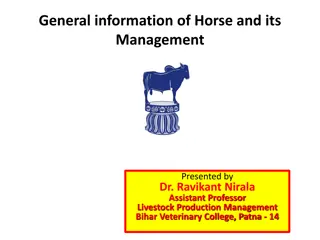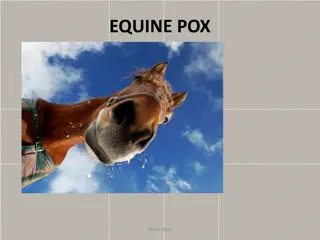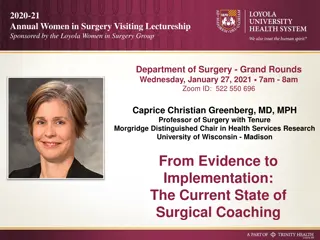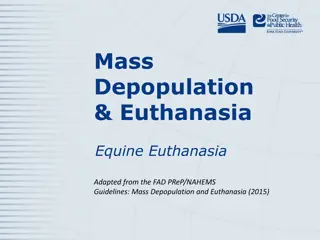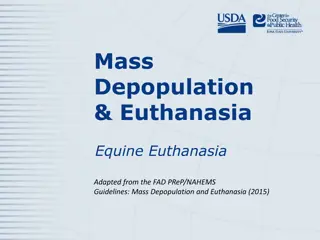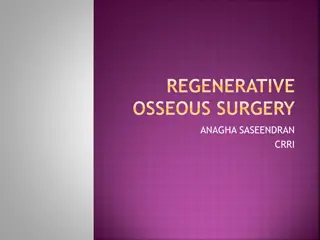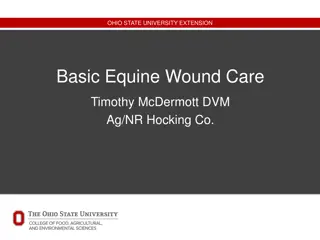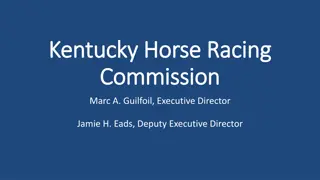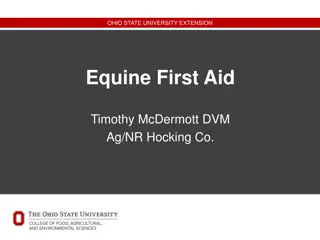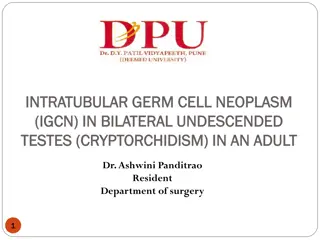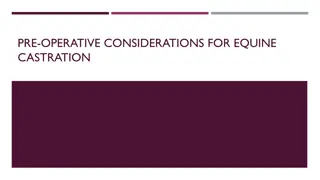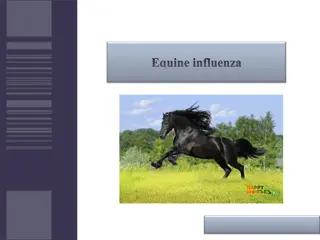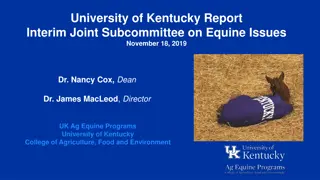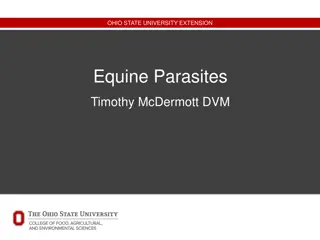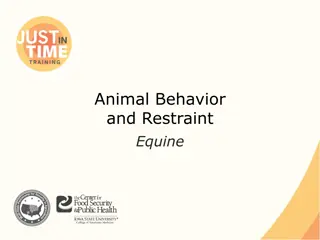Equine Surgery Techniques for Cryptorchidism Management
Learn about the inguinal and abdominal approaches for managing cryptorchidism in horses. The procedure involves general anesthesia, patient preparation, surgical techniques, and intra-operative steps. Explore images and videos detailing the steps involved in the process.
Download Presentation

Please find below an Image/Link to download the presentation.
The content on the website is provided AS IS for your information and personal use only. It may not be sold, licensed, or shared on other websites without obtaining consent from the author.If you encounter any issues during the download, it is possible that the publisher has removed the file from their server.
You are allowed to download the files provided on this website for personal or commercial use, subject to the condition that they are used lawfully. All files are the property of their respective owners.
The content on the website is provided AS IS for your information and personal use only. It may not be sold, licensed, or shared on other websites without obtaining consent from the author.
E N D
Presentation Transcript
INGUINAL APPROACH CRYPTORCHIDISM
Cryptorchid Laparoscopy PRE-OP https://www.youtube.com/watch?v=DiKYiv85dtk&ab PREPARING THE PATIENT
GENERAL ANESTHESIA Xylazine and Ketamine maintained using the triple drip technique POSITIONING Dorsal recumbency using limb supports, inflatable cushions, foam wedges PREPARATION OF SITE Aseptic preparation of Inguinal area (Inguinal Approach) Ventral abdomen (Para-inguinal Approach
1. Withhold food for approximately 4 to 8 hours before surgery except in foals (Do not withhold water) 2. Perform a complete physical examination with emphasis on cardiorespiratory function 3. Determine body weight using a scale or a girth weight estimator tape (note body type e.g., lean/racing, conditioned, draft) 4. Groom the horse and wipe with a moist cloth to remove dander and debris 5. Clean the feet before induction; pull or pad shoes to prevent injury 6. Prepare (clip and scrub) the surgical site 7. Place and secure an IV catheter in a jugular vein before induction
INGUINAL CRYPTORCHID Abdominal Cryptorchidism Complete Equine INTRA-OP https://www.youtube.com/watch?v=bbsy_L5M Pt0&has_verified=1&ab_channel=ThomazCoelh o
INSTRUMENTATION 1. General surgery pack 2. Sponge forceps 3. Emasculator
TECHNIQUE: 1. Make a 12-15cm skin incision over the external inguinal ring 2. Continue through superficial fascia and bluntly dissect with fingertips to separate the subcutaneous inguinal fascia and expose the external inguinal ring. 3. Continue dissecting beyond the external inguinal ring 4. Dissect through the inguinal canal until the vaginal ring is located 5. Isolate the common tunic and remove the testis using a close castration technique Close the external inguinal ring with a large-diameter synthetic absorbable suture material in a preplaced interrupted pattern 6. 7. Close the dead space using a no. 2-0 synthetic absorbable suture material 8. Suture the skin with a synthetic absorbable suture with simple interrupted sutures with long ends.
ABDOMINAL CRYPTORCHID Abdominal Cryptorchidism Incomplete Equine INTRA-OP https://www.youtube.com/watch?v=lfGxnA04t Mc&ab_channel=ThomazCoelho
The intra-op procedure for an abdominal cryptorchid surgery is similar to steps 1-4 of the aforementioned Inguinal approach to the inguinal cryptorchid. 1. Make a 12-15cm skin incision over the external inguinal ring 2. Continue through superficial fascia and bluntly dissect with fingertips to separate the subcutaneous inguinal fascia and expose the external inguinal ring. 3. Continue dissecting beyond the external inguinal ring 4. Dissect through the inguinal canal until the vaginal ring is located
5. Introduce a curved sponge forceps carefully through the inguinal canal, advancing it through the vaginal ring into the vaginal process 6. Press the partially opened jaws of the forceps against the vaginal process, when the forceps close against the vaginal process grasp the vaginal process and gubernaculum testis 7. Withdraw the forceps carefully, without rupturing the vaginal process 8. Palpate the gubernaculum within the everted vaginal process by rolling it between thumb and forefinger 9. Using a Metzenbaum scissors open the vaginal process, graps the gubernaculum with Ochsner forceps.
10. Apply traction to the gubernaculum to exteriorize the tail of the epididymis, pulling the testis through the vaginal ring 11. Emasculate the testis (nut to nut) after identifying the structure. 12. If the testis cannot retracted for emasculation ligate the cord and sharply amputate the testis 13. Close the external inguinal ring with a large-diameter synthetic absorbable suture material in a preplaced interrupted pattern 14. Close the dead space using a no. 2-0 synthetic absorbable suture material 15. Suture the skin with a synthetic absorbable suture with simple interrupted sutures with long ends.
PARAINGUINAL APPROACH CRYPTORCHIDISM
PARAINGUINAL APPROACH INTRA-OP
INSTRUMENTATION 1. General surgery pack 2. Sponge forceps 3. Emasculator 4. Spay hook (parainguinal approach)
TECHNIQUE: 1. Make a 10cm incision through the skin parallel to and 4cm axial to the inguinal canal 2. Explore the inguinal canal to assess the presence of an inguinal testis. 3. If no inguinal testis is present make a 10cm incision into the external rectus sheath (no deeper) 4. Bluntly divide the rectus abdominus muscle and bluntly penetrate the internal rectus sheath along with the peritoneum 5. Place a spay hook through the incision into the peritoneal space 6. Sweep the tip of the spay hook through the region of the vaginal ring, picking up the gubernaculum
7. Remove the gubernaculum from the abdomen and place traction | until the testis is removed from the abdomen 8. Emasculate the testis 9. Close the external rectus sheath in a simple continuous pattern using no.1 polyglyconate 10. Close the subcutaneous tissue and skin using a no. 2-0 synthetic absorbable suture material in a simple continuous pattern
Post-op management of the patient is similar in the Inguinal Approach (inguinal and abdominal cryptorchid) and the Para-inguinal Approach. Administer tetanus immunization Routine post castration management Clean any blood or discharge around incision Hospitalize for 72 hours if the inguinal canal was closed with sutures Exercise the horse after 2 weeks POST-OP




